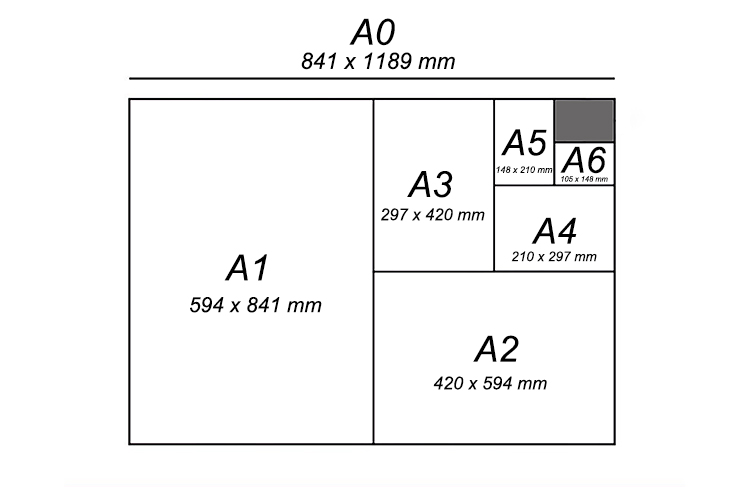Australia Standard Trim Size for Printing
If you are new in printing, understanding the standard trim sizes for different products in Australia is crucial. Whether it's for a marketing campaign, publishing a book, or creating personal projects, choosing the right paper size can significantly impact the final product's effectiveness and appeal.
In this comprehensive guide, we will delve into the standard paper sizes, standard book printing sizes, product sizes in Australia, and provide a handy paper size chart along with tips on choosing the right size for your printing project.
Standard Paper Size

A0
The A0 size is the largest in the series, measuring a grand 841 x 1189 mm. This size serves as the foundation from which all other sizes are derived. It's commonly used for technical drawings, posters, and architectural plans, where detail and clarity on a large scale are essential. The expansive surface area of A0 allows for intricate details to be displayed without compromise, making it an ideal choice for presentations that require impact and precision.
A1
Stepping down slightly in size, A1 measures 594 x 841 mm. It strikes a balance between the vastness of A0 and the more manageable dimensions of smaller sizes. A1 is frequently utilized for large posters, detailed charts, and as a preferred size for academic conference posters. It offers ample space for visual elements and text, making it versatile for both professional and creative applications.
A2
At 420 x 594 mm, A2 is a popular choice for medium-sized posters, architectural drawings, and retail signage. It provides a generous canvas for designs yet is easier to handle and display than its larger counterparts. A2's dimensions are conducive to eye-catching displays in a variety of settings, from art galleries to trade shows, ensuring visibility and engagement from the audience.
A3
A3, measuring 297 x 420 mm, is a versatile size widely used in offices, classrooms, and creative studios. Its dimensions are well-suited for reports, presentations, and artwork reproductions. A3 can accommodate detailed information and graphics without overwhelming the viewer, making it a favored option for educational materials and technical documents.
A4
A4 is perhaps the most recognized and used paper size worldwide, with dimensions of 210 x 297 mm. It is the standard size for everyday printing needs, including letters, books, documents, and forms. A4's ubiquity in offices and homes alike underscores its practicality for a broad range of applications, from business correspondence to academic papers.
A5
Half the size of A4, A5 measures 148 x 210 mm. This compact size is perfect for notepads, booklets, notebooks, and flyers. A5's smaller dimensions make it easy to carry and distribute, ideal for promotional materials and personal diaries. It strikes a balance between readability and convenience, offering sufficient space for information while remaining portable.
A6
A6 is even smaller, at 105 x 148 mm, making it an excellent choice for postcards, pocket-sized notebooks, and invitation cards. Its petite size lends a sense of intimacy and exclusivity to the communication, suitable for personal messages and boutique marketing efforts.
Standard Book Printing Sizes

A4
In the realm of book printing, A4 remains a common choice for textbooks, manuals, and workbooks. Its ample area allows for clear, legible text and detailed illustrations, making it ideal for educational and instructional materials where clarity and accessibility are paramount.
A5
A5's popularity extends into book printing, particularly for novels and non-fiction titles. Its handy size is convenient for readers, fitting comfortably in bags and on bookshelves. A5 offers a balance between portability and readability, making it a universally appealing option for publishers.
Novel
The novel size, typically around 203 x 127 mm, is a traditional choice for fiction works. This size feels right in the hands of readers, providing an immersive reading experience without the bulkiness of larger formats. It's a testament to the enduring appeal of the printed word in an increasingly digital world.
Demy size
Demy size, measuring approximately 216 x 138 mm, is a slightly larger option favored for premium novels, memoirs, and academic titles. Its dimensions offer additional margin space for notes and a comfortable reading experience, bridging the gap between portability and functionality.
Square
Square books, with dimensions varying but often around 210 x 210 mm, stand out for their unique shape. This format is particularly popular for art books, cookbooks, and children's books, where the square layout accommodates both text and illustrations harmoniously.
Children's books
Children's books come in a variety of sizes, but larger formats (like 203 x 203mm) are common to accommodate vivid illustrations and larger text. The dimensions are chosen to captivate young readers' imaginations and make it easier for adults to read along. This category prioritizes the visual and tactile experiences of reading, with sizes often deviating from the standard to suit the story and artwork.
Product Sizes
Catalog
Catalogs vary in size, but A4 and A5 are predominant choices, providing a balance between space for product displays and ease of handling. The size chosen often reflects the brand's aesthetic and the volume of information to be conveyed, with larger catalogs benefiting from the A4's spacious layout.
Magazine
Magazines typically adopt the A4 size for its visual and practical advantages. The format accommodates diverse content, from articles to advertisements, with clarity and impact. A4's popularity in magazine printing underscores its effectiveness in engaging readers and supporting high-quality imagery.
Brochure/booklet
Brochures and booklets are versatile in size, but A4 and A5 are common selections. These sizes are conducive to concise, impactful presentations of information, whether folded or bound. The choice of size is integral to the brochure's or booklet's ability to capture attention and convey its message effectively.
Comic book
Comic books often use a standard size of around 170 x 260 mm(US standard), though variations exist. This size is chosen to enhance the storytelling experience, with ample space for artwork and dialogue. The dimensions reflect the industry's conventions and the readers' expectations, contributing to the immersive quality of the medium.
Playing card
Playing cards typically measure 63 x 88 mm, a size that balances ease of handling with sufficient space for design elements. This standard size is the result of centuries of evolution, optimized for gameplay and durability.
Tarot card
Tarot cards are larger, usually around 70 x 120 mm, to accommodate detailed imagery and symbolism. The size enhances the visual impact and usability of the cards, important factors in tarot readings and the aesthetic appreciation of the decks.
Poster
Posters leverage the larger sizes of A0, A1, A2, and A3 to make a visual statement. The choice of size depends on the intended impact and the environment in which the poster will be displayed. Each size offers a different balance of visibility and detail, suited to various contexts and messages.
Leaflet/flyer
Leaflets and flyers are effective in sizes like A5, A6, DL, providing concise information in a compact format. These sizes are easy to distribute and convenient for recipients to carry, making them ideal for promotional activities and information dissemination.
Notebook
Notebooks are commonly found in A5 and A6 sizes, catering to different needs and preferences. A5 notebooks offer more space for notes and drawings, while A6 notebooks are more portable, perfect for jotting down ideas on the go.
Paper Size Chart
A visual paper size chart is an invaluable tool for comparing the dimensions and applications of different paper sizes at a glance. It can guide decision-making in printing projects, ensuring the chosen size aligns with the project's goals and requirements.
Check out the chart below which shows the different paper sizes in millimeters and inches.
| Paper Size |
Dimensions (MM) |
Dimensions(IN) |
| A0 |
841 x 1189 mm |
33.11in x 46.81in |
| A1 |
594 x 841 mm |
23.4in x 33.1in |
| A2 |
420 x 594 mm |
16.5in x 23.4in |
| A3 |
297 x 420 mm |
11.7 in x 16.5in |
| A4 |
210 x 297 mm |
8.3in x 11.7in |
| A5 |
148 x 210 mm |
5.8in x 8.3in |
| A6 |
105 x 148 mm |
4.1in x 5.8in |
Tips for Choosing the Right Size for Your Printing Project
Choosing the correct size for your printing project involves considering the purpose of the printed material, the target audience, and the method of distribution. Larger sizes can make a bold statement but may be less practical for handouts,. Smaller sizes are convenient but may limit the amount of information or visual impact. Always consider the balance between the content's needs and the practicalities of printing and distribution.
In conclusion, the standard trim sizes for printing in Australia cater to a wide range of purposes, from personal projects to professional publications. Understanding these sizes and their applications can enhance the effectiveness and appeal of your printed materials. Whether you're designing a book, creating marketing materials, or planning a poster, choosing the right size is a critical step in achieving your vision and engaging your audience.
At Chinaprinting4u, we provide a wide range of standard sizes and custom sizes for printing your project. Whether you want to print standard size, custom size or die cut shape, we can meet your needs. If you need help or for more info, please contact us now!

